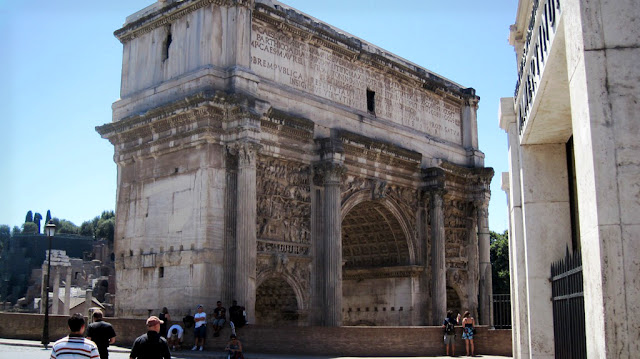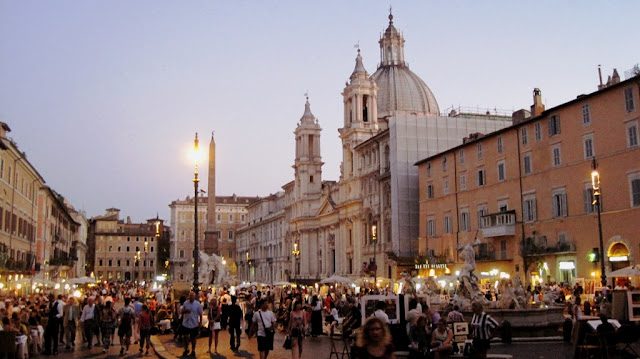Reliving 17 July
The first thing I noticed when I woke up this morning is
that it appears our bedrooms will double as a sauna. We don't have central air, so living with
warmer temperatures in the summer will have to be something I get used to! I walked out of my bedroom for the showers
and the hallway was about 15 degrees cooler, no joke. I suppose I should have known about the
sweltering weather, since our rooms on the first day included two complementary
1.5 L bottles of l'acqua (water!). The
perspiration continued all day today, we'll see if my suspicions of
no-relief-from-the-heat continue to be confirmed.
Today we toured the first of the four major basilicas in
Rome, St. John Lateran. The other three
are St. Mary Major, St. Paul Outside the Walls, and St. Peter's. St. John Lateran is beautiful (over and above
the already beautiful city). It is the
first Christian church built in history and has been around in one form or
another on that spot since before 313 A.D. It was given to the bishop of Rome by Roman emperor
Constantine after he was converted to Christianity and decreed for the first
time that the faith would no longer be persecuted in the Roman Empire.
As the story goes (this is the approximate story, I can't
remember it exactly) he received a vision of the Cross before going into a
major battle and was promised that it would bring him victory. So he put that symbol on the shields of his
army and ended up routing his foe. He
then converted to the God who granted him this victory and afterwards allowed Christianity
to be freely practiced. It eventually became
the official religion of the Roman empire.
We actually were given the tour of the basilica by an
English-speaking Scottish nun in a green habit named Sister Manuela. Apparently this was her third year doing the
tour for the College, and I soon found out why they want her to keep coming
back. She was so knowledgeable and filled
with joy about telling the story not only of the basilica (probably for the
thousandth time) but of the Faith upon which that basilica was dedicated and
built. I wish I took a picture with her;
luckily I got one of her back by accident.
So apparently, basilicas in ancient times were the place
of the local king, specifically the place of his throne, where you would go if
you had business with him. Especially
early on, Christianity used familiar images and terms like these from the local
culture and "Christianized" them as a means of evangelization to
bring people into a relationship with Christ and the Church. So, St. John Lateran in like fashion was
dubbed a basilica, in order that pilgrims might know this was the meeting place
not with the local king, but with the King of Kings.
You'll notice if you do a little research that there is
no such Saint as St. John Lateran. The
basilica itself is dedicated to Sts. John the Baptist and John the Evangelist. It was the Lateran family who gave the land
to build our first church, so it seems their generosity would be continually
remembered throughout the ages even unto today.
 |
| How do you get these things to be upright? |
 |
| Sister Manuela to the right! |
 |
| The current facade seen here was designed in 1735 by Alessandro Galilei |
I'm bummed, looking at my camera I see that I didn't take
any pictures of the inside. I will get
back there at some point and post them for you.
Inside, among many other works of art, are massive sculptures of the
Twelve Apostles (the Eleven plus St. Paul), six on each side which line the main
nave all the way up to the high altar.
Each of them are holding their weapon or means of martyrdom (every one
of them was martyred for the Church except St. John the Evangelist, who died of
old age). Above them are twelve, imagine
sculpted paintings that hang on the wall.
Six depictions of Old Testament stories on one side, and on their
corresponding opposite the six New Testament moments in Christ's life that
fulfilled or made clear these Old Testament symbols. The idea was (and still is) to show the unity
and inseparability of the Old Testament and the New Testament in Christian
faith and life. How the Old foreshadows
the New by means of symbol, and how the New illuminates the meaning of the Old
by means of fulfillment.
Above the main altar of the basilica in the baldacchino (it's that four legged dome structure you see covering the altar or the
tabernacle in really old churches) are some of the skull relics of Sts. Peter
and Paul themselves (you can't actually see them as they are hidden in
reliquaries). But man was it cool to be
so near to the bones of two men who saw Christ Himself.
We had Mass in the chapel of the ancient baptistery. As you can guess, the baptistery was where
soon-to-be Christians were baptized. It
is actually a separate structure next to the basilica. Early Christians were very protective of the
faith (especially because it was so new and historically so persecuted), so you
couldn't just walk into St. John Lateran if you weren't Christian or weren't
seriously interested in becoming Christian.
The idea of a baptistery outside the church building was to make more
concrete this reality of being once outside of communion with God's family, and
then dying and being born to a new life of grace by the waters of baptism, so
that subsequently you could come into the basilica and enjoy the heavenly
wedding banquet (the Mass) with your new family and the Kings of Kings.
The dome above the baptistery itself is octagonal,
symbolizing the seven days of creation plus the Resurrection day of Christ, a
recapitulation or rebirth, a new beginning of a redeemed creation. In Genesis we read that on the seventh day
God rested, and this was the Sabbath, the completion of creation. Fast forward to the Gospels where we read
that Jesus died the day before Sabbath and was hastily buried, but rose again
on the morning following the Sabbath.
Hence the eighth day. Beautiful
expression of Christian faith using art?
Yup.
 |
| The sculpture in the middle is obviously not original, but you can see how big the entire font is. I am zoomed in from the other side. The water would have been up to that wooden door. Full immersion baptism. |
After Mass, we went across the street to what used to be
the place where all the popes lived. At
the moment I don't remember the name of the building. St. Peter's Basilica (the complex where the
pope now lives) is relatively newer in the scheme of Church history, so for
many centuries the popes lived at St. John Lateran. Still to this day the pope is the "official
pastor" of the Lateran.
At any rate, we got to see his private chapel, in which there is a
triptych (a hinged, three sided type of religious art) reputedly painted by St.
Luke the Evangelist (and as pious tradition holds, was finished by the angels).
St. Helena, the mother of Constantine the Great, flexed
the royal muscle and had the steps of the Roman praetorium in Jerusalem transplanted
from there back to Rome, where they eventually found their way to the pope's
house across from the Lateran. These are the Scala Sancta, the Holy Steps
Jesus walked up to be condemned to death by Pilate. Pilgrims come to these steps daily to kneel
all the way up to the top (you are not allowed to walk up them). At the top of the steps is the pope's private
chapel. It was pretty awesome, take a look.
 |
| Non est in toto sanctior orbe locus. Roughly translated, there is no holier place in all the world. |
 |
| Tile mosaic above the altar and triptych |
 |
| Sideways view (grrr) of the Scala Sancta. They are now covered with wood for protection. You can see the original marble through the slats. The pope's chapel is on the other side of that grated window at the top. |
This evening we walked into the city for a gelato run at
this place called the Frigidarium (famous amongst the seminarians here). Rome is a different city at night. All the small winding streets are lit up and
people are sitting outside restaurants enjoying their cena ('cheh-na', dinner). We walked through this big open piazza along
the way, take a look below, this is at sunset when things just start to get
going.
Overall an awesome day, but exhausting once more. I am super sore from so much walking!












































